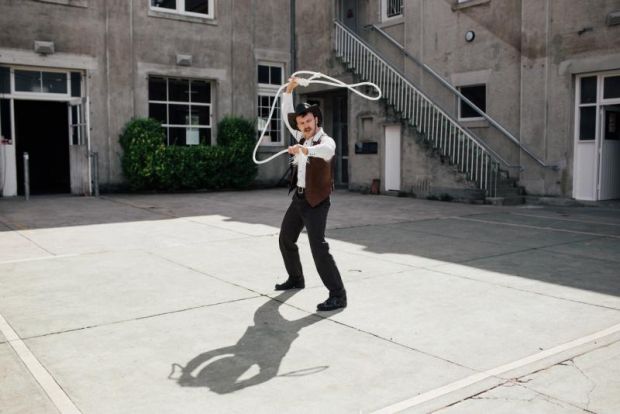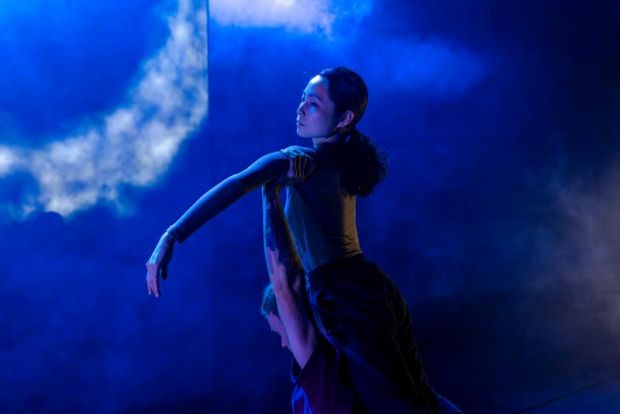sixbythree
Image above from Epilogue. Photo by Yo.
sixbythree brings the rare opportunity to see how three different choreographers interpret the world in contemporary dance. Serious issues, unusual imaginings, personal reactions are told in dance stories that are contained and controlled in movement and rhythm and time. Five of the six performances are described below.
 Photographer: Anne Moffatt.
Photographer: Anne Moffatt.
Cowboy
Creator/Performer Michael Smith
Producer The Farm
Michael Smith performs his creation Cowboy in the wide space of Riverside’s amphitheatre to a “free-roaming” audience, some of whom become part of a “wild west” experience where he lives out a fantasy that exposes “desires and vulnerabilities that exist in our pursuit to form identity”.
He enters the space as himself and wanders to an area where he sees “cowboy” clothes laid out. He stops, considers, then gives in to the chance to become his “imagined cowboy self”.
He strips and dons the dark trousers, shirt, waistcoat, boots and hat. As the transformation is completed, the music (composed by Ben Ely) changes to a faster rhythm. He picks up a lariat, trips into the noose … and becomes an untamed horse and rider, rearing and galloping until man eventually overcomes beast and they canter up to a saloon.
The piece then becomes interactive as Smith entices members of the audience to set up the saloon – the swinging doors, the bartender, a pianist, some drinkers. In mime he gives them movements to which he will return as he acts out a typical bar room scenario involving drinking, flirting, a dance routine and a cleverly staged slow motion fight.
Smith ends this scene sleeping off the effects until a change in music – bells, the sound of wind – rouses him and ‘dances’ him dream-like to another space where he picks up a bag, sets up a fire, plays a harmonica and talks briefly (in wild west drawl of course) about being a loner until the sound of shooting sends him ducking, weaving and eventually falling to lie still in a pool of light that fades slowly.
This narrative is creatively perceived and cleverly performed. Smith combines dance and drama, using movement, characterisation, mime, humour and the power of suggestion to engage – and disarm – his audience in a form of storytelling that is universal.
Quartette
Lewis Major Projects
FORM dance Projects
Riverside Theatres Parramatta
Quartette includes “four unique repertoire pieces (that) investigate various poetic possibilities, universal rhythms and cycles”. The first of these is …
 Photographer: Alessandro Botticelli
Photographer: Alessandro Botticelli
Two x Three
Choreographer Russell Maliphant OBE
To music composed by Andy Cowton, three performers – Clementine Benson, Elsi Faulks and Stefaan Morrow – weave an intricate routine that shifts between them, sometimes simultaneous, sometimes led by one or the other, always connected by movement, but strictly contained by space, confined as each is to a square of white light (designer Michael Hulls) shining from above. In that space they react to shimmering high notes, reaching slowly, the light above shadowing the contours their bodies create.
The movements Maliphant has devised are clear and carefully controlled, slow at first suggesting a sort of languor that changes as the music becomes faster, the percussive notes causing fast, contortive movement. Here the dancers are confined to a smaller square of black that appears within each ‘cell’ of white light. Despite the increased speed and complexity of the choreography, they never move outside the restriction of that confined space, their control and balance and their synchronicity sustained until the light above them closes to black.
This is an intriguing piece of choreography that shows the talent, fitness and amazing control of the performers – and how perfectly they are in tune with the rhythms of the music and each other. There was a just audible sigh of appreciation from the audience as the light faded on this first very interpretation of “universal rhythms and cycles”.
Mort Cynge
Choreographer Lewis Major
Camille Saint Saens composed the music for this beautiful but sad interpretation of a dying swan. Lewis Major’s choreography is delicate and demanding and Clementine Benson performs it with moving grace. She is a skilled artist, able to give the performance character and depth as well as executing the intricate fading moments of the elegant creature she depicts.
Carefully controlled leaps suggest memories of a time past, a stronger hold on life, a need to stay – all there in Benson’s face as well as her body as her swan clings on to the last few moments of life. Music and movement blend in this quiet, gentle dance story … a moving homage to Tchaikovsky’s ballet told in contemporary choreography that is delicately and evocatively executed.

Lament
Choreographer Lewis Major
Stefaan Morrow begins this third piece of Quartette. Major’s choreography to Italian operatic music gives Morrow the opportunity to show his artistry in a complex routine of leaps and twists, sliding at times, until a seeming realisation of weakness and defeat leaves him lying, still and lifeless. A woman approaches slowly, lies over him and gently brings him back to life. In this ‘new life’ he rises with the woman on his back – and for the remainder of the performance holds her almost as a part of himself.
Elsi Faulks never touches the ground in this difficult, strictly coordinated routine. She sits on Morrow’s shoulders, twists under him, is lifted above him, twirled around him as he moves them both in his new incarnation. This is a concentrated piece of choreography that demands perfect coordination, excellent timing and complete trust. Both performers need to be extremely fit and strong as well as in complete synch with each other and the music. Not once did they falter as they executed this complicated routine which was almost mesmerising to watch.
 Photographer: Alessandro Botticelli
Photographer: Alessandro Botticelli
Epilogue
Choreographer Lewis Major
A dark Stage, A shadowy figure. A soft whispery sound. Light fades up slowly on a still white figure. Dust drifts from her statuesque hands and her long hair and settles in a powdery circle at her feet. Slowly she begins to move, each movement clouded by particles of white, her feet creating interconnecting circles in the fine particles in which she stands.
Clementine Benson is clothed in these fine white particles. They sift from her hair, waft from her arms as she reaches up to the light, puff from under her feet as she slides her feet in long, circling movements to music composed in the style of Debussy by Dane Yates.
This most unusual piece of choreography is true to Lewis Major’s ethos of presenting “surprisingly real dance works in multiple mediums”. It is challenging for the performer in choreography and control – and in the “costume” that permeates and diffuses with every movement creating an atmosphere that is ghostly and even a little macabre.
A strange Epilogue to this interesting Quartette of contemporary “rhythms and cycles”.
Reviews by Carol Wimmer
Subscribe to our E-Newsletter, buy our latest print edition or find a Performing Arts book at Book Nook.

